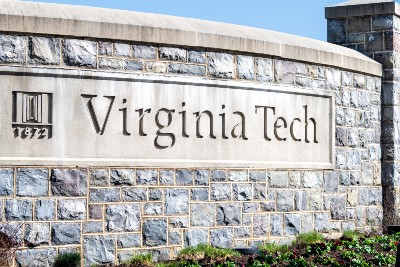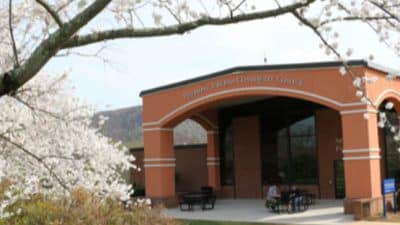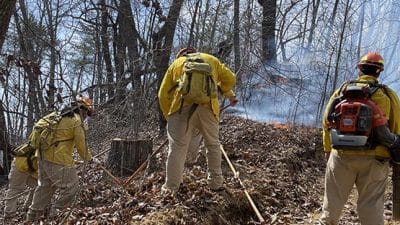
On a cool April morning in the fold of the Catawba Valley, leaves crunched underfoot and the air smelled of spring. Through the brown detritus on the forest floor, spikes of green foliage sprung from the earth — telltale signs of the changing of the seasons.
A quartet of researchers stepped over streams and fallen trees as they reached their destination: a slope of a hill. Tool in hand, Jim Chamberlain, a research forest product technologist with the U.S. Forest Service, reached into the dirt and carefully pulled up what looked like a wild onion.
The group wasn’t there to harvest ramps, as these wild leeks are colloquially known in Appalachia. They were there to make sure that ramps are here for future generations to enjoy, just as they have in the South for centuries.
It is here, at the Catawba Sustainability Center, that Virginia Tech researchers work with the U.S. Forest Service to find the best growing methods for ramps to allow the delicacy to last far into the future.
Ramps are steeped in regional history. Back in the 1750s, people from Europe – especially Ireland and Scotland – brought knowledge to their newfound homeland of a plant they harvested in their homeland called ramsons. They found a similar plant in Appalachia, harvested it, and called it ramps.
Around 100 years ago, community and civic groups started to have festivals to celebrate the arrival of spring that coincided with the harvesting of ramps – one of the first plants to arrive that season.
That cultural tie has only strengthened in the years since the festivals began and are deeply engraved in Appalachia, where festivals celebrating the springtime plant each year.
Ramps have blossomed elsewhere, too. The ’90s saw the plant featured prominently in The New York Times. Now, you can find hikers throughout Appalachia looking for the plant on the slopes of the Blue Ridge Mountains.
But an increase in popularity has led to a concern for overharvesting of this delicacy.
To fight this over-loving of ramps, the team of researchers is developing methods to grow ramps in contained environments. These studies could allow farmers to grow on land that isn’t used for current crops, boosting profits while lessening the burden on wild ramp populations.
Pabitra Aryal, a Ph.D. candidate in the College of Agriculture and Life Sciences’ School of Plant and Environmental Sciences, is researching the onion’s cousin by growing ramps from seed and bulb to study the germination time of the plant.
Aryal, along with her Ph.D. mentor John Fike, a professor in the School of Plant and Environmental Sciences, Adam Taylor, manager of the Catawba Sustainability Center, and Chamberlain, Aryal puts forgotten land to use – slopes of hills covered in dense foliage that farmers wouldn’t otherwise use.
At the center, she tests the impact of Endomycorrhizal fungi, which has a beneficial relationship with plants and could positively influence the growth rate of ramps on both bulbs and seeds. Little is known about the germination time, though Appalachian lore says it could take as long as seven years.
“We want to see if Endomycorrhizal fungi can speed up this process to make it more economically and logistically viable for farmers,” Aryal said.
Aryal was interested in geographic information system mapping with medicinal plants – another use of ramps – and wanted to connect these modeling efforts to agroforestry.
To get the entire picture of the region’s ramps, Aryal and Fike tested plants from around Appalachia for growth rate and how Endomycorrhizal fungi may impact plants based on their region. The researchers also planted ramp bulbs and seeds in plots located across the Catawba Sustainability Center.
“Without support from College of Agriculture and Life Sciences, this project wouldn’t be possible,” Fike said.
With additional support from Outreach and International Affairs, Aryal’s research on ramps was underway.
A regional partnership
Catawba Sustainability Center, located in the Catawba Valley near Hokie favorite McAfee Knob, is a 377-acre farm that serves as a laboratory to advance environmental stewardship and community engagement and is part of Outreach and International Affairs. The center provides a learning environment for the research, teaching, and demonstration of sustainable practices in agriculture, forestry, and land management.
Researching ramps at the center was a logical choice, Taylor said.
“The ramps project fits in our model of using marginal land that can’t be cultivated or grazed to order to produce a product that can diversify a farm and create multiple systems of income generation,” Taylor said. “We also work with a number of edible and medicinal non-timber forest products at the center.”
To help local farmers, the center is starting a nontimber forest product herb network, where forest farmers in the region can come to the Catawba Sustainability Center and learn firsthand from Virginia Cooperative Extension experts.
Ultimately, Aryal and Fike want local and regional farmers to benefit from this research, as it could help them determine if their land is suitable for growing the Appalachian delicacy.
Testing the viability of forest farming of ramps could open the door to a whole host of other crops for farmers – mushrooms, ginseng, and other products – further boosting the financial success of farms with forests.
“The work that Virginia Tech is doing to figure out how to grow this plant will ensure that the entities that harvest them, the community, and the people that benefit from them will be able to do so in perpetuity,” said Chamberlain, who earned his Ph.D. from the College of Natural Resources and Environment in 2000. “Without this kind of research, there’s no way to ensure that there’s a sustainable sourcing of this plant.”
In the interim, Chamberlain said, ramps can be harvested in a manner that allows the plant to reproduce. Instead of pulling the bulb and roots from the ground, the leafy greens can be cut to allow the plant to repopulate.










